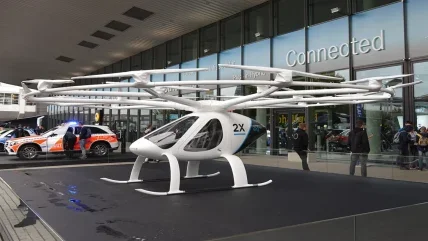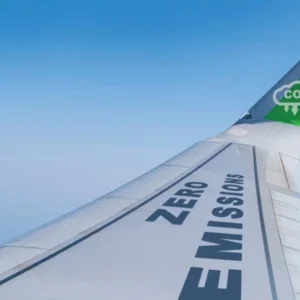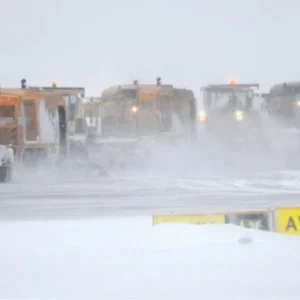
The 1950s were perhaps the most optimistic time in history. With the Nazis defeated, the Soviets restrained, and household income soaring from New York to Frankfurt, writers and intellectuals let their imaginations fly free. And though fantastical ideas of the future permeated everywhere, from human-made planets to nuclear-powered toilets, nowhere was this influence stronger than in the field of aviation. Early in the decade, for instance, Popular Mechanics magazine envisaged a world where suburbanites would all own a personal helicopter, landing on their front lawns every evening like a Cadillac. By 1957, the same publication announced the imminent arrival of ‘flying fan vehicles’, available in four-door and truck models and capable of reaching speeds of 50mph.
Whether you have tiptoed barefoot along sticky airport carpets, or stood through a crotch-level interrogation by an over-keen police dog, it is clear that the cheery tomorrow promised in those post-war years has failed to materialise. Though statistics are generally scarce, one 2017 survey found that 47% of Americans thought airport hassles had become worse over the preceding five years. Yet, amid a thoroughgoing revolution in how aircraft are envisaged and built – and broad shifts in how officials think about the aviation industry – the future may soon start looking rather brighter. Flying fan sedans are still not on the menu but, buoyed by new technology, companies are dramatically boosting the prospects of so-called ‘electric vertical take-off and landing’ (eVTOL) vehicles. Taking helicopters and making them more efficient and sustainable, these machines could eventually be a fixture of skylines the world over.
Not, of course, that we should expect traffic jams in the sky over Big Ben anytime soon. Between technical challenges and regulatory hurdles, there is plenty more for eVTOL evangelists to reflect on. The same goes for infrastructure on the ground. After all, if these machines hope to break traditional aviation’s monopoly on air travel, let alone compete with well-established public transport systems, they obviously need check-in and boarding at new ‘vertiports’ to be as straightforward as possible. And here, too, there is evidence that operators are finding success. Liaising closely with airports and city officials, manufacturers are banking on a future where hopping on an eVTOL is as simple as catching a train – with potentially monumental ramifications for global aviation.
A flying start
The aviation industry has been talking about eVTOLs for years. As far back as 2009, Nasa showcased a single-person rendering of the machines, a presentation which soon went viral. Yet, speak to Ankit Dass and it is clear that these machines have only genuinely come of age in the very recent past. “I would say that from 2020 onwards, there’s been a lot more momentum,” says Dass, CTO at Skyports, a London aerial mobility company. “Companies are a lot more recognisable now, and are testing more products.”
According to work by Research Dive, the global eVTOL industry is expected to reach $4.2bn by 2033, representing yearly growth of 29.6%. That is echoed by the rise of a number of companies. In the US, for example, Archer Aviation lately announced an eVTOL deal with United Airlines worth $1bn. In the UK, Bristol-based Vertical Aerospace is supplying 100 machines to Japan Airlines, with another 100 going to AirAsia.
This expansion can be understood in several ways – most notably in the form of upgrades in eVTOL technology itself. As a spokesperson for Volocopter, a German eVTOL manufacturer, explains, the past decade has seen significant advances everywhere from chassis materials to battery power. All this has important consequences in the real world. The latest eVTOL prototypes, such as Volocopter’s VoloCity model, can now fly for over 20 miles without needing to be recharged. Access to light and high-strength composites, for their part, ensures that eVTOLs can take off vertically with ease. At the same time, manufacturers are using technology to boost the sustainability of their machines. Beyond the obvious environmental benefits of rechargeable batteries, Volocopter has, for instance, developed special rotors that keep noise pollution low.
As that torrent of deals implies, these technical upheavals are also being accompanied by a revolution in attitudes. As Dass puts it, distributors are “getting so much recognition”. Yet if the eVTOL aircraft itself has come into its own, that means little if they have nowhere to land, or if navigation is too dangerous. That has historically been a special challenge given many insiders see congested cities as eVTOLs’ stomping grounds. But here, too, change is – quite literally – in the air. Among other things, Dass explains how better radar technology increasingly helps eVTOLs criss-cross dense urban environments. That is overshadowed by more fundamental shifts. Until recently, the few eVTOLs that had permission to fly over towns and cities have tended to partner with traditional airports. Now, though, companies are busy investing in their own bespoke vertiports, with one city at the southern tip of the Malay Peninsula hinting at what that could mean for passengers.
Enjoy the airtime
When it opens sometime in 2024, Singapore’s first Skyports vertiport will be like no other airport in history. That is clear even before the facility has been built. Renderings show no sign of looming control towers or endless runways – because individual eVTOLs only need 25m² of tarmac, this will be a decidedly bijou set-up.
These differences are sure to continue, suggests Dass, once passengers head inside. Instead of queuing to drop off their bags, or putting their coats through metal detectors, he instead imagines they will just turn up, with automated security technology flagging any would-be interlopers. Another partner in the Singapore project, Volocopter is just as eager to highlight the simplicity of these plans. “Initially,” the company says, “a customer ticket will likely cost more than other forms of public transportation – but significantly less than helicopter rides and will offer much more efficient travel”.
This focus on speed and accessibility hints at how eVTOLs could be used in practice. By cutting the rigamarole from air travel, they are perfect for short urban trips, carrying busy passengers between neighbourhoods, or from suburban airports to downtown hotels. Given they are likely to supplement existing transport infrastructure, it should come as no surprise that traditional airports are also interested in eVTOLs. Near Paris, for instance, Pontoise-Cormeilles Airport has begun work to become Europe’s first vertiport, with Volocopter conducting flight trials in early 2022. Across the Channel, Heathrow hopes to be flying air taxis to Cambridge by the middle of the decade, possibly cutting the journey by up to an hour compared with land-based vehicles. More to the point, Volocopter is keen to emphasise the need to liaise with traditional airports, even if vertiports ultimately end up looking quite different. They might not have long runways, but these facilities will still need to contend with local officials, civil aviation authorities and anxious local residents.
Beyond the question of passenger transportation, meanwhile, industry insiders are increasingly excited for what eVTOLs may do for freight. As Dass puts it, if an eVTOL can comfortably transport four people, imagine how many packages it could carry instead? In a similar vein, experts are also exploring the power of unmanned flying vehicles. Wingcopter is a case in point. Capable of flying at 90mph, the German company’s unmanned drones may soon be used to deliver medical supplies to remote rural clinics. Skyports, for its part, has invested heavily in so-called ‘drones as a service’, allowing customers to outsource their delivery needs to Dass and his colleagues. Given institutions as varied as the UK’s Royal Mail and the NHS are doing just that, it seems clear that this approach has potential.
Clear skies ahead?
In February 2022, the eVTOL sector received some unwelcome news. In an SEC filing, Joby, a US drone company, admitted that one of its machines had crashed during a test flight in the California countryside. Among other things, it appears the eVTOL was being flown at 270mph, around 70mph faster than the drone’s supposed top speed. In light of the incident, Joby was unsurprisingly keen to reassure the industry. As the company put it: “Safety is a core value for Joby, which is why we have been expanding our flight envelope with a remote pilot and in an uninhabited area, especially as we operate outside expected operating conditions.”
Of course, the broader implications here should not be exaggerated – not all drones are bound to be flown at such reckless speeds. Even so, the Joby crash does signal some of the potential issues around eVTOLs, particularly when it comes to safety. Though regular aircraft have had over a century to secure the affection of punters, these newcomers are largely unknown. No wonder, then, that manufacturers are pushing to get their machines approved by regulators. The European Union Aviation Safety Agency (EASA), to take but one example, is liasing with Volocopter to develop rules around keeping both passengers and ground crews secure – a process Volocopter describes as “overwhelmingly positive”. On 24 March, as a result of these discussions, among others, the EASA released a 179-page document as the world’s first official guidance for building vertiports for air taxis and other eVTOL aircraft. In the US, the Federal Aviation Association (FAA) is hard at work developing its own guidelines.
Another challenge involves technology. Though eVTOLs have come far over the past decade, Dass warns that issues remain, with charging stations needing particular attention. To put it bluntly, even the best batteries will soon become dead weights without the ability to recharge. But, just like Volocopter’s work with the EASA, companies like Skyports are pushing forward, integrating charging and energy infrastructure into their vertiports. That dovetails with other developments – such as ensuring that machines enjoy greater flying stability than regular helicopters.
Similarly, the cost of developing vertiports could prove prohibitive, particularly in the early days of the technology, with management consulting firm McKinsey & Company estimating that each vertiport facility could cost between $200,000 and $7m to build. Though he concedes that a new world will not arrive tomorrow, Dass believes that eVTOLs will likely mature into a fully-fledged industry over the next few decades. “If you include the whole Greater London area,” he says as an example, “you might expect about 50 vertiports.” The miraculous future envisaged by Popular Mechanics is not here just yet – but it is getting closer.
$4.2bn
The estimated value of the eVTOL industry by 2033.
Research Dive
$7m
The potential cost of a vertiport facility, depending on size and mission.
McKinsey & Company






